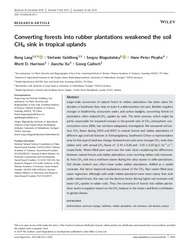Converting forests into rubber plantations weakened the soil CH4 sink in tropical uplands
Goldberg, Stefanie
Piepho, Hans-Peter
Harrison, Rhett D.
Xu, Jianchu
Cadisch, Georg
DOI: https://doi.org/10.1002/ldr.3417
Persistent URL: http://resolver.sub.uni-goettingen.de/purl?gldocs-11858/9380
Persistent URL: http://resolver.sub.uni-goettingen.de/purl?gldocs-11858/9380
Lang, Rong; Goldberg, Stefanie; Blagodatsky, Sergey; Piepho, Hans-Peter; Harrison, Rhett D.; Xu, Jianchu; Cadisch, Georg, 2019: Converting forests into rubber plantations weakened the soil CH4 sink in tropical uplands. In: Land Degradation & Development, Band 30, 18: 2311 - 2322, DOI: 10.1002/ldr.3417.
 |
Dokument öffnen: |
Large-scale conversion of natural forest to rubber plantations has taken place for decades in Southeast Asia, help to make it a deforestation hot spot. Besides negative changes in biodiversity, ecosystem water, and carbon budgets, converting forests to plantations often reduced CH4 uptake by soils. The latter process, which might be partly responsible for resumed increase in the growth rate of CH4 atmospheric concentrations since 2006, has not been adequately investigated. We measured soil surface CH4 fluxes during 2014 and 2015 in natural forests and rubber plantations of different age and soil textures in Xishuangbanna, Southwest China—a representative area for this type of land-use change. Natural forest soils were stronger CH4 sinks than rubber soils, with annual CH4 fluxes of −2.41 ± 0.28 and −1.01 ± 0.23 kg C ha−1 yr−1, respectively. Water-filled pore space was the main factor explaining the differences between natural forests and rubber plantations, even reverting rubber soils temporarily from CH4 sink into a methane source during the rainy season in older plantations. Soil nitrate content was often lower under rubber plantations. Added as a model covariate, this factor improved explanation power of the CH4 flux—water-filled pore space regression. Although soils under rubber plantation were more clayey than soils under natural forest, this was not the decisive factor driving higher soil moisture and lower CH4 uptake in rubber soils. Thus, the conversion of forests into rubber plantations exerts a negative impact on the CH4 balance in the tropics and likely contributes to global climate.
Statistik:
ZugriffsstatistikSammlung:
Schlagworte:
deforestationland-use change
methane
rubber plantation
soil moisture
soil texture
tropics
This is an open access article under the terms of the Creative Commons Attribution License, which permits use, distribution and reproduction in any medium, provided the original work is properly cited.

